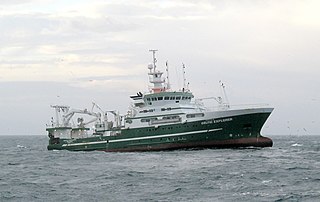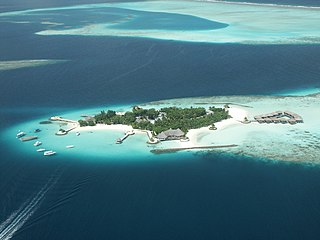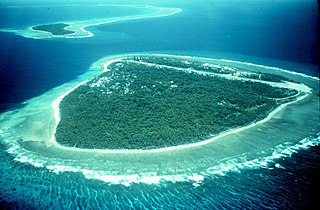Related Research Articles

Trawling is a method of fishing that involves pulling a fishing net through the water behind one or more boats. The net used for trawling is called a trawl. This principle requires netting bags which are towed through water to catch different species of fishes or sometimes targeted species. Trawls are often called towed gear or dragged gear.

Bycatch, in the fishing industry, is a fish or other marine species that is caught unintentionally while fishing for specific species or sizes of wildlife. Bycatch is either the wrong species, the wrong sex, or is undersized or juveniles of the target species. The term "bycatch" is also sometimes used for untargeted catch in other forms of animal harvesting or collecting. Non-marine species that are caught but regarded as generally "undesirable" are referred to as "rough fish" and "coarse fish".

Overfishing is the removal of a species of fish from a body of water at a rate greater than that the species can replenish its population naturally, resulting in the species becoming increasingly underpopulated in that area. Overfishing can occur in water bodies of any sizes, such as ponds, wetlands, rivers, lakes or oceans, and can result in resource depletion, reduced biological growth rates and low biomass levels. Sustained overfishing can lead to critical depensation, where the fish population is no longer able to sustain itself. Some forms of overfishing, such as the overfishing of sharks, has led to the upset of entire marine ecosystems. Types of overfishing include: growth overfishing, recruitment overfishing, ecosystem overfishing.

Bottom trawling is trawling along the seafloor. It is also referred to as "dragging". The scientific community divides bottom trawling into benthic trawling and demersal trawling. Benthic trawling is towing a net at the very bottom of the ocean and demersal trawling is towing a net just above the benthic zone. Bottom trawling can be contrasted with midwater trawling, where a net is towed higher in the water column. Midwater trawling catches pelagic fish such as anchovies and mackerel, whereas bottom trawling targets both bottom-living fish (groundfish) and semi-pelagic species such as cod, squid, shrimp, and rockfish.
Midwater trawling is trawling, or net fishing, at a depth that is higher in the water column than the bottom of the ocean. It is contrasted with bottom trawling. Midwater trawling is also known as pelagic trawling and bottom trawling as benthic trawling.

The live fish trade can refer to the live food fish trade or to the ornamental fish trade. The fish can come from many places, but most comes from Southeast Asia.

Southeast Asian coral reefs have the highest levels of biodiversity for the world's marine ecosystems. They serve many functions, such as forming the livelihood for subsistence fishermen and even function as jewelry and construction materials. Corals inhabit coastal waters off of every continent except Antarctica, with an abundance of reefs residing along Southeast Asian coastline in several countries including Indonesia, the Philippines, and Thailand. Coral reefs are developed by the carbonate-based skeletons of a variety of animals and algae. Slowly and overtime, the reefs build up to the surface in oceans. Coral reefs are found in shallow, warm salt water. The sunlight filters through clear water and allows microscopic organisms to live and reproduce. Coral reefs are actually composed of tiny, fragile animals known as coral polyps. Coral reefs are significantly important because of the biodiversity. Although the number of fish are decreasing, the remaining coral reefs contain more unique sea creatures. The variety of species living on a coral reef is greater than anywhere else in the world. An estimation of 70-90% of fish caught are dependent on coral reefs in Southeast Asia and reefs support over 25% of all known marine species. However, those sensitive coral reefs are facing detrimental effects on them due to variety of factors: overfishing, sedimentation and pollution, bleaching, and even tourist-related damage.

Blast fishing, fish bombing, dynamite fishing or grenade fishing is a destructive fishing practice using explosives to stun or kill schools of fish for easy collection. This often illegal practice is extremely destructive to the surrounding ecosystem, as the explosion often destroys the underlying habitat that supports the fish. The frequently improvised nature of the explosives used, and undetonated charges, means danger for fishermen and divers as well, with accidents and injuries.

Marine conservation, also known as ocean conservation, is the protection and preservation of ecosystems in oceans and seas through planned management in order to prevent the over-exploitation of these marine resources. Marine conservation is informed by the study of marine plants and animal resources and ecosystem functions and is driven by response to the manifested negative effects seen in the environment such as species loss, habitat degradation and changes in ecosystem functions and focuses on limiting human-caused damage to marine ecosystems, restoring damaged marine ecosystems, and preserving vulnerable species and ecosystems of the marine life. Marine conservation is a relatively new discipline which has developed as a response to biological issues such as extinction and marine habitats change.

Unsustainable fishing methods refers to the utilization of the various fishing methods in order to capture or harvest fish at a rate which sees the declining of fish populations over time. These methods are observed to facilitate the destructive fishing practices that destroy ecosystems within the ocean, and more readily results in overfishing, the depletion of fish populations at a rate that cannot be sustained.
In respect of fishing techniques, cyanide fishing is a specific method of collecting live fish, mainly for use in aquariums, which involves spraying a sodium cyanide mixture into the desired fish's habitat in order to incapacitate the fish. This practice affects not only the target population, it also has negative and damaging effects on many other marine organisms, including coral and coral reefs.

The environmental impact of fishing includes issues such as the availability of fish, overfishing, fisheries, and fisheries management; as well as the impact of industrial fishing on other elements of the environment, such as bycatch. These issues are part of marine conservation, and are addressed in fisheries science programs. According to a 2019 FAO report, global production of fish, crustaceans, molluscs and other aquatic animals has continued to grow and reached 172.6 million tonnes in 2017, with an increase of 4.1 percent compared with 2016. There is a growing gap between the supply of fish and demand, due in part to world population growth.

Fishing techniques are methods for catching fish. The term may also be applied to methods for catching other aquatic animals such as molluscs and edible marine invertebrates.

A wild fishery is a natural body of water with a sizeable free-ranging fish or other aquatic animal population that can be harvested for its commercial value. Wild fisheries can be marine (saltwater) or lacustrine/riverine (freshwater), and rely heavily on the carrying capacity of the local aquatic ecosystem.
This page is a list of fishing topics.
This is a glossary of terms used in fisheries, fisheries management and fisheries science.

The fishing industry in the Maldives is the island's second main industry. According to national tradition in the words of former President Maumoon Abdul Gayoom, "Fishing is the lifeblood of our nation, it is inborn. From the soil on which we live, to the sea around us, it remains an integral part of our existence. Fishing, and our country and its people, [are] one and shall remain inseparable forever." The Maldives has an abundance of aquatic life and species of fish. Common are tuna, groupers, dolphin fish, barracuda, rainbow runner, trevally and squirrelfish and many more. Aside from being of essential importance to the economy, fishing is also a popular recreational activity in the Maldives, not only among locals but by tourists. The islands have numerous fishing resorts which cater for these activities.

Human activities have significant impact on coral reefs. Coral reefs are dying around the world. Damaging activities include coral mining, pollution, overfishing, blast fishing, the digging of canals and access into islands and bays. Other threats include disease, destructive fishing practices and warming oceans. The ocean's role as a carbon dioxide sink, atmospheric changes, ultraviolet light, ocean acidification, viruses, impacts of dust storms carrying agents to far-flung reefs, pollutants, algal blooms are some of the factors that affect coral reefs. Evidently, coral reefs are threatened well beyond coastal areas. Climate change, such as global warming, causes a rise in ocean temperatures that lead to coral bleaching which can be fatal to the corals.
The following outline is provided as an overview of and topical guide to fisheries:
Saltwater fish, also called marine fish or sea fish, are fish that live in seawater. Saltwater fish can swim and live alone or in a large group called a school.
References
- ↑ Explosions In The Cretan Sea: The scourge of illegal fishing -- fishing with explosives.
- ↑ "Beam trawling on the North Sea". Greenpeace. Archived from the original on 2008-12-10. Retrieved 2009-01-12.
- ↑ United Nations General Assembly Session 59 Verbatim Report56. A/59/PV.56 page 4. Ms. Kimball International Union for the Conservation of Nature and Natural Resources 17 November 2004. Retrieved 2009-05-09.
- ↑ FAO: Destructive fishing practices [ dead link ]

